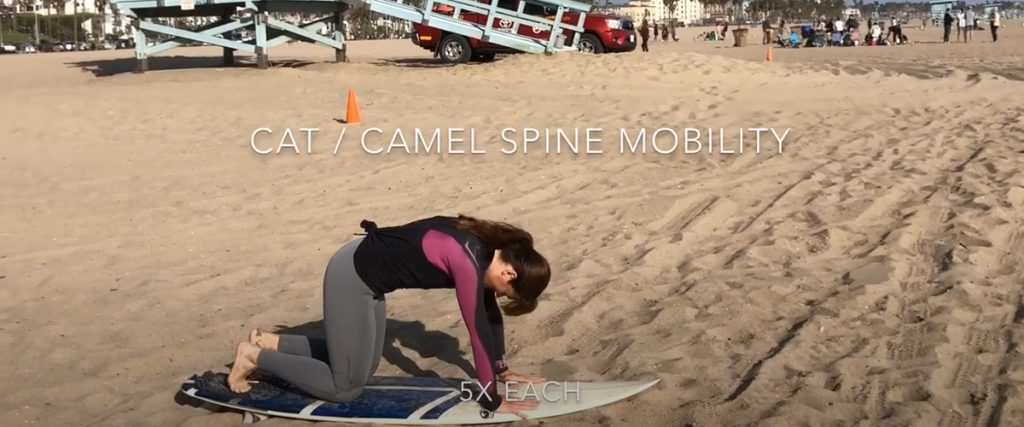SURF STRENGTH SERIES
Dynamic Warmup for Surfers Research is clear that a dynamic warm-up (vs. static stretching) is best to prepare for sport ️ and to prevent injuries. A sport-specific warm-up is specially designed to move the body through the necessary range of motion and activate the neuromuscular system in ways that simulate the sport. Surfing is a high demand sport with significant injury risk. Up to ⅓ of surfers sustain an injury each year requiring medical attention, missed work, or time off from surfing, and 91% of surfers have sustained an injury surfing in their lifetime. We see lots of injured surfers at Elevate. Most often we hear that they don’t warm-up at all,🤭 and don’t have an exercise regimen to get their bodies strong for the great demands of surfing. A surf-specific dynamic warm-up will go a long way to help mitigate the risks and prevent injury (especially when combined with our surf-specific strength exercises coming next week). We know the waves are like a Siron song calling you the minute you feel the sand in your toes, but put earplugs in for just 5 minutes and prepare your body for the awesome intensity of surfing! What a surf-specific dynamic warm-up can do for YOU: Increase core temperature Increase blood flow to muscles Increase stimulation to mechanoreceptors in joints Increase stimulation to the central nervous system Increase musculoskeletal control Increase confidence for performance Increase movement through the range of motion demands for the upcoming activities Improve exercise / sport performance Reduce risk for injury Scap Strength for Surfers Surfers, swimmers, water polo players and other water sport athletes who present with shoulder pain often have weakness in / poor control of posterior chain shoulder girdle musculature including the infraspinatus of the rotator cuff and the trapezius scapular muscles. . Elevate Founder Dr. Meredith Soelberg PT, DPT, MBA demonstrates a few simple exercises to address the common deficits. All you need is a Theraband to help get these specific muscles doing their job better for top SPORT PERFORMANCE and to PREVENT INJURY. Shoulder external rotation with Theraband – this is a TWO STEP exercise, to emphasize the scapula stabilizers and the infraspinatus cuff muscle. Squeeze shoulder blades together and down to stabilize. 2. With elbows at 90 degrees and at your sides, AND shoulder blades squeezed together and down, PULL the band apart. Hold 3 seconds. Slowly release. Repeat 10x. 3 sets… Cheerleader Series’ Ts and diagonals with Theraband – stand tall, shoulders away from ears. T – will emphasize the middle trapezius fibers. Elbows straight, shoulders at 90 degrees, pull band apart to make a T shape. Give a squeeze to your shoulder blades at opening of the T. Then slowly release back to start position. Alternating Diagonals – will emphasize numerous important scapular muscles reciprocally. Start in the same start position as the T exercise. Pull band apart with one arm pulling up, the other pulling down. Palms face forward, the band is in a diagonal, elbows straight. Give a squeeze to your shoulder blades Meet back in the start position. Then do the opposite diagonal. . . What’s great about the diagonals is the reciprocal movement pattern it trains – very functional for the movement in these sports!. 1 T + 1 diagonal each direction = 1 rep. Repeat 10x. 3 sets. ❗️KEEP ELBOWS STRAIGHT. ❗️ . If you’re having shoulder pain, come in and our Doctors of Physical Therapy can evaluate it, get you out of pain, and started on an injury and sport specific program. Need a Theraband? We’ve got all colors! Strengthen your Serratus Anterior for Surfing The Serratus Anterior does so much for the surfer! It wears a lot of hats as a protractor / abductor, posterior tilter, upward rotator and stabilizer of the shoulder blade! It’s particularly important in the intricate biomechanics of reaching overhead in the paddle, and for a strong pop-up. … Lack of control, strength, or activation of this important muscle is believed to be associated with painful shoulder conditions found in surfers and other water sport and “overhead” athletes. Here’s a progression of “scapula pushups” with a Theraband for added resistance to isolate that serratus anterior, and at the same time, work your core muscles that are also critical for surfers and water sport athletes! Try 3 sets of 15 of level 1. When that gets easy, try the next level!.



